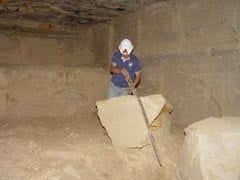Stone Sources: Park Lane Bath Stone returns
It has taken five years and will have cost £800,000 to bring Park Lane underground Bath Stone quarry back into production 50 years after it was closed, but its an investment Ham & Doulting Stone believe was well worth making to return one of the great Bath Stones to the market.
Obtaining planning permission to re-open what was described by Derek Hawkins in a book called Bath Stone Quarries published last year as “one of the most successful quarries in the Corsham area” took Ham & Doulting longer than it had anticipated. But now it is cutting a new access road into the underground quarry so that block can once again be extracted.
The quarry, called Park Lane, is below Neston Park in Wiltshire, the estate owned by the Fuller brewery family where the TV programme ‘Lark Rise to Candleford’ was recorded. The existing workings underground extend over 26acres and the planning permission extends to another 200acres. Ham & Doulting do not anticipate any shortage of the stone within the lifespan of anyone currently alive.
The quarry was originally opened in 1880. It was never the easiest quarry to work because it was remote and prone to flooding. Marks on the walls clearly show the water level reached almost to the roof, and written on the wall next to some abandoned blocks of excellent quality stone is the message “Stone left due to flooding, 1955”.
There are many messages left on the limestone walls. Some are workings showing the amount of stone extracted. Some are just graffiti recording loves and frustrations. Some are in memoriam to colleagues who lost their lives in accidents in the mines.
And they are mines, even though, historically, they are called underground quarries. The reason they were called quarries is because the producers of block stone liked to distinguish themselves from miners producing coal and other minerals, who they considered less skillful and were paid less.
Park Lane used to be worked by Hanson, but was closed in February 1960. Modernism, with its love of concrete, had reduced demand for dimensional stone and Hanson had easier quarries to work.
In the 1970s the shaft was filled with rubble and the entrance was blocked off, which has left the interior looking like an industrial museum. There are old pillar cranes, oak water butts and handsaw blades left where they were last used. There are cobbled stables where the ponies that still hauled the stone after World War II were housed. There are personal items such as snuff and match boxes.
A small opening had been dug through the blocked shaft into the quarry in the 1990s, which enabled Ham & Doulting to identify the potential of the stone there.
Then, having gained the backing of the land owners to start working the quarry, Ham & Doulting re-opened the entrance fully to explore it more thoroughly. Crucially, it believes a new water pumping station nearby has solved the problem of flooding in the quarry.
Under the Review of Mineral Planning Permissions (ROMPs), Park lane Quarry already had planning permission for the extraction of block, but that would have involved using the previous access, which is too small and steep for modern trucks.
Gaining planning permission for a new entrance, which involves a 160m tunnel dropping 9m, took five years and cost £77,000 (not including management time). It is reached along a new 1,110m track across a field from the road to the new entrance.
An extra cost will involve blocking off a section of the mines to create a sanctuary for the lesser and greater horseshoe bats found there. By the time the quarry re-opens, Ham & Doulting Director Zak England estimates the total cost of bringing it back into production will have been around £800,000. That includes putting two Fantini saws into the quarry, one to cut the stone from the face and the other to size the blocks ready for storage in the 1,500m2 collection area at the entrance.
The Fantinis should be operational before the end of the year, making the stone available again from the beginning of next year.
“Demand for Bath stone is crazy at the moment,” says Zak. “We’ve had loads of people get in touch with us and I’m confident we can sell everything we get out of the ground.”
As a bonus, the excavations for the new entrance have revealed Forest Pennant above the Bath Stone, which the company plans to use to surface the new track from the road and which it might be able to opencast later if planning permission can be obtained.
Bath Stone not sold as block will be taken to Ham & Doulting’s processing yard at Tout Quarry, where the company already processes its own Lias, Doulting and Ham Hill limestones.
Zak says he has now also been offered a chance to operate another Lias quarry, which he will pursue. So would he like more quarries after that? “Too right I would!"

